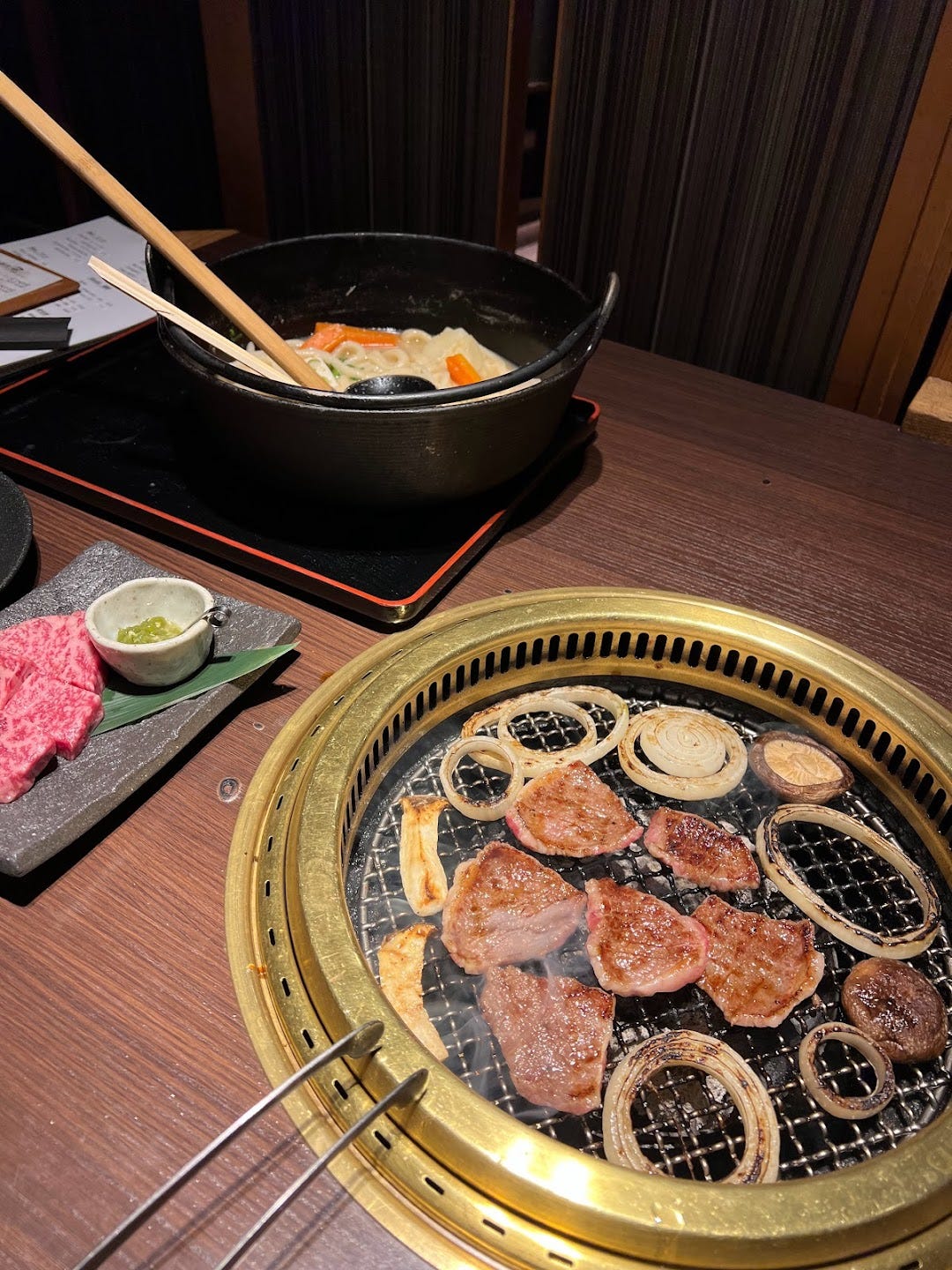The smallest of Japan’s four main islands, Shikoku is all too often overlooked by its bigger, more famous counterparts. Shikoku (shi - four, koku - countries) is split into four prefectures - Kagawa, Ehime, Kochi and Tokushima, with each one having its own gourmet specialities and cultural draws.
For those who have completed Japan for beginners and want a more off-the-beaten-track rural experience, there is no better place to go. With its famous 88-temple pilgrimage trail, stunning landscapes and hearty regional cuisines, Shikoku offers the opportunity to see a different, quieter (but no less amazing) side to Japan.
This 1-week road trip itinerary takes you through all four prefectures, starting / ending in Osaka (which is the nearest major city and transportation hub just outside of Shikoku):
Day 1: Osaka
Day 2: Takamatsu
Day 3: Konpira-san / Iya Valley
Day 4: Kochi
Day 5: Nakatsu Gorge / Matsuyama
Day 6: Naoshima
Day 7: Osaka
The following can also be tacked onto a week spent in Tokyo / Kyoto / Osaka as part of a longer holiday in Japan! For ideas on what to do in these cities, check out my itinerary here.
Day 1: Osaka
This vibrant foodie city is often characterised as friendlier and more digestible than the capital, Tokyo. It’s also the closest major city to Shikoku (save for Kobe, but I think Osaka has more to see) and therefore has plentiful options for car hire, which is why I’d recommend starting from here.
We picked up our pre-booked car from Nissan Rent-a-car at Kansai International Airport and found the whole process to be typically Japanese in its efficiency and ease. Note that UK drivers will require an international driving permit as well as their physical driving licence to drive in Japan. Helpfully, Japan drives on the left!
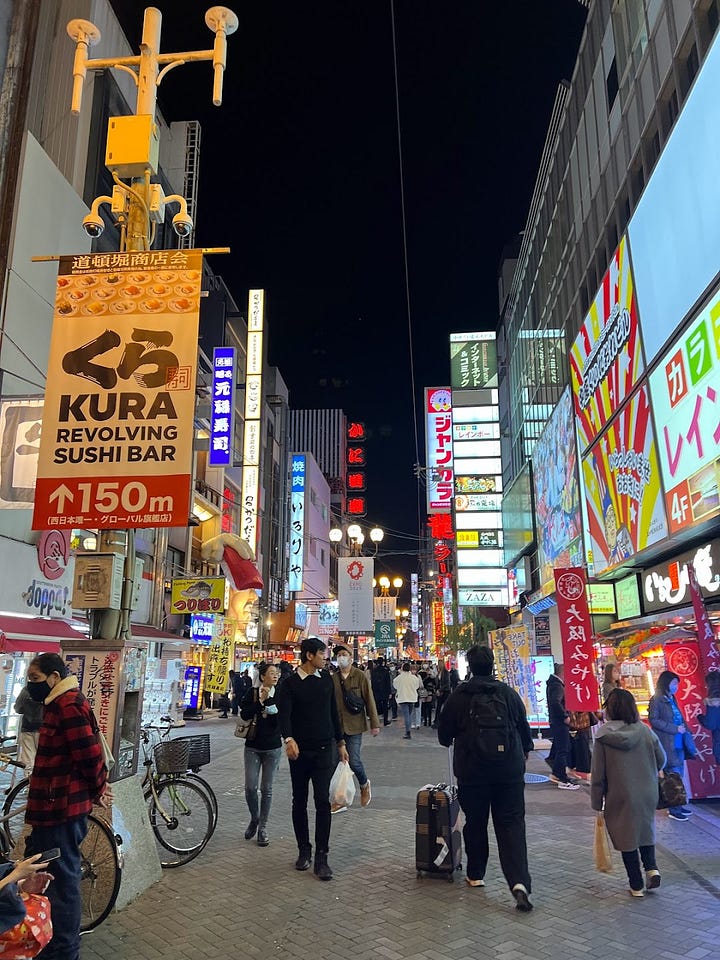
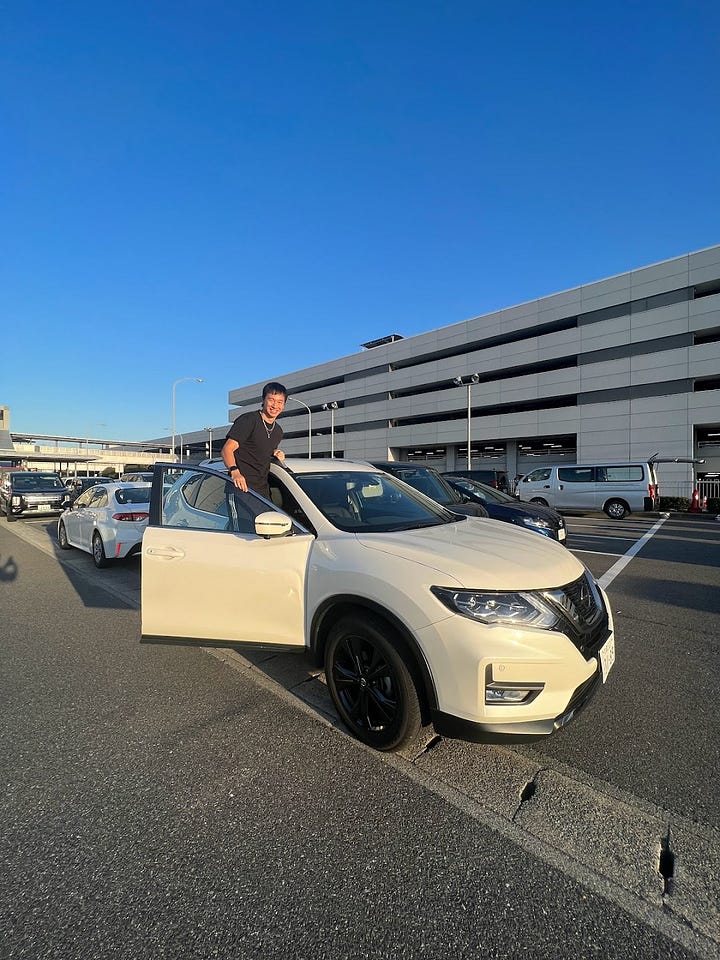
For my recommendations on what to do in Osaka, check out my “Japan, for beginners” itinerary here and skip to days 10-12.
Day 2: Takamatsu
Today your epic road trip begins in earnest as you undertake the scenic 2 hours 40 minutes’ drive from Osaka to Takamatsu, the capital of Kagawa prefecture and your first stop in Shikoku. If you’d like to break up the drive, you could stop by the Naruto Whirlpools, a natural phenomenon where dramatic whirlpools appear in the sea - but note that the whirlpools only appear at certain times of day, so make sure to check the timetable before committing to go.
Where we stayed in Takamatsu
Fav Hotel Takamatsu: this sleek and modern hotel is self-service from check-in to check-out, but they have plenty of amenities that are free for you to take at reception. Rooms are comfortable, very spacious and equipped with everything you could need, including a washing machine. There is also free parking (just make sure to let them know you need a space when booking). Ideally located in a quiet yet central part of town.
Takamatsu’s most famous dish (and Kagawa prefecture more generally) is unquestionably sanuki udon, with these thick white noodles characterised by its firm, chewy texture derived from the special type of wheat used. You can enjoy a bowl at Udon Baka Ichidai - a traditional, no frills popular shop that is conveniently located near Fav Hotel Takamatsu and full of locals at lunchtime. The dish they’re best known for is their butter udon, but their sukiyaki beef udon topped with an onsen egg is arguably even better.
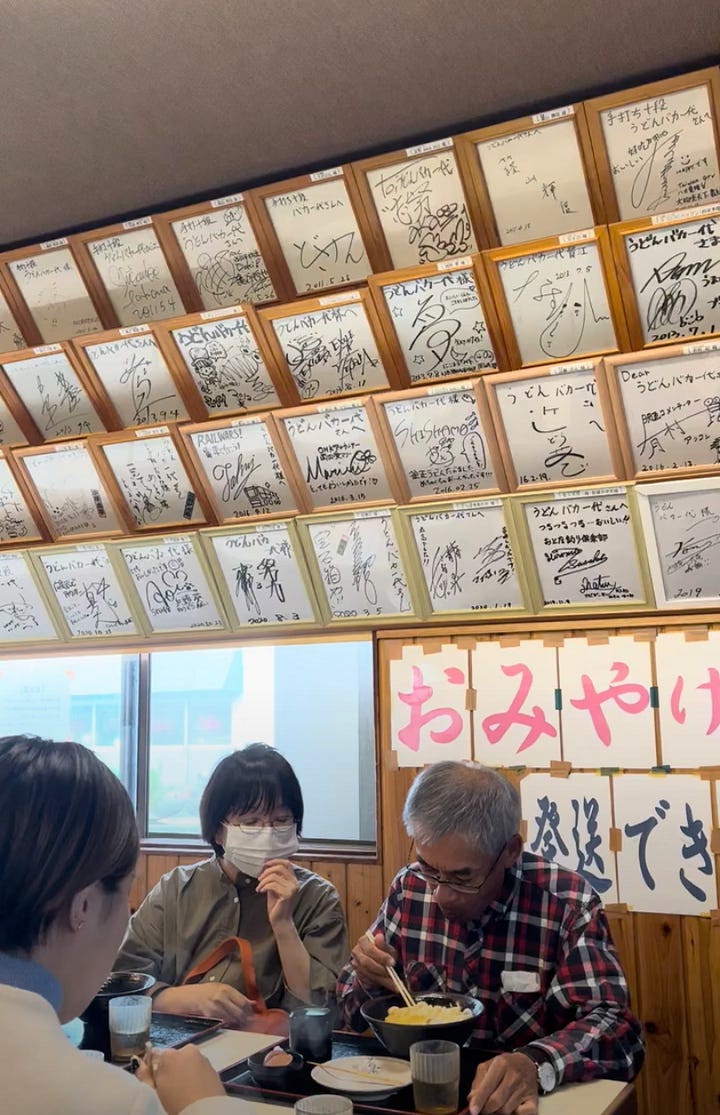
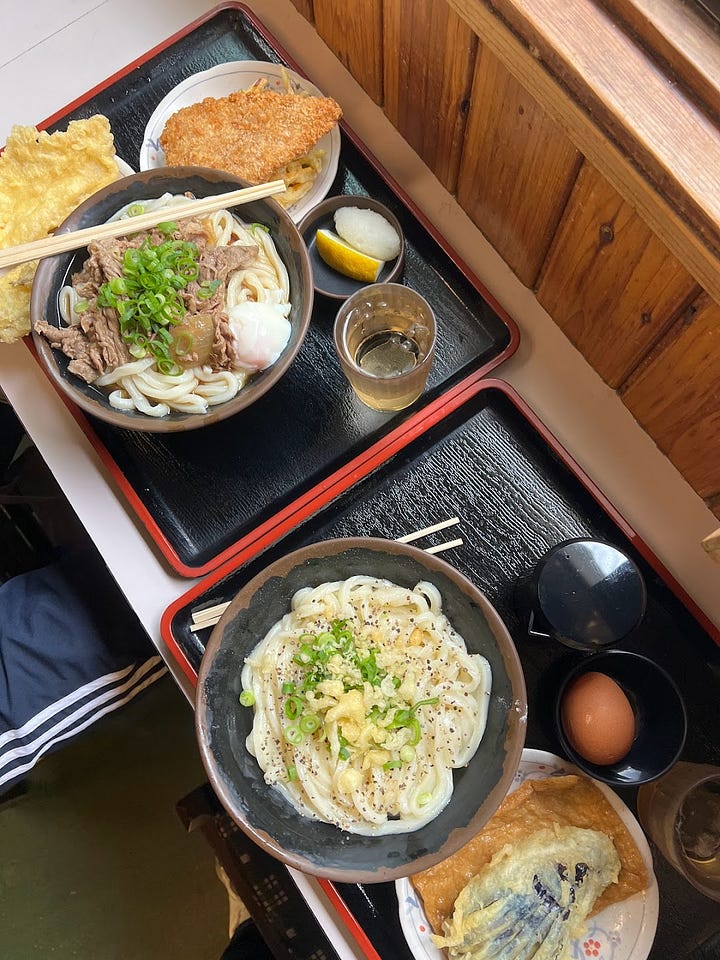
The main draw of Takamatsu is the unparalleled Ritsurin Garden, renowned across Japan for its scenic beauty. Built during the 18th century by feudal lords, this garden is better thought of as a park through which you can stroll at leisure and enjoy the ponds, hills, trees and stunning pavilions, which includes a teahouse where you can sip on matcha whilst marvelling at the beautiful vista in front of you.
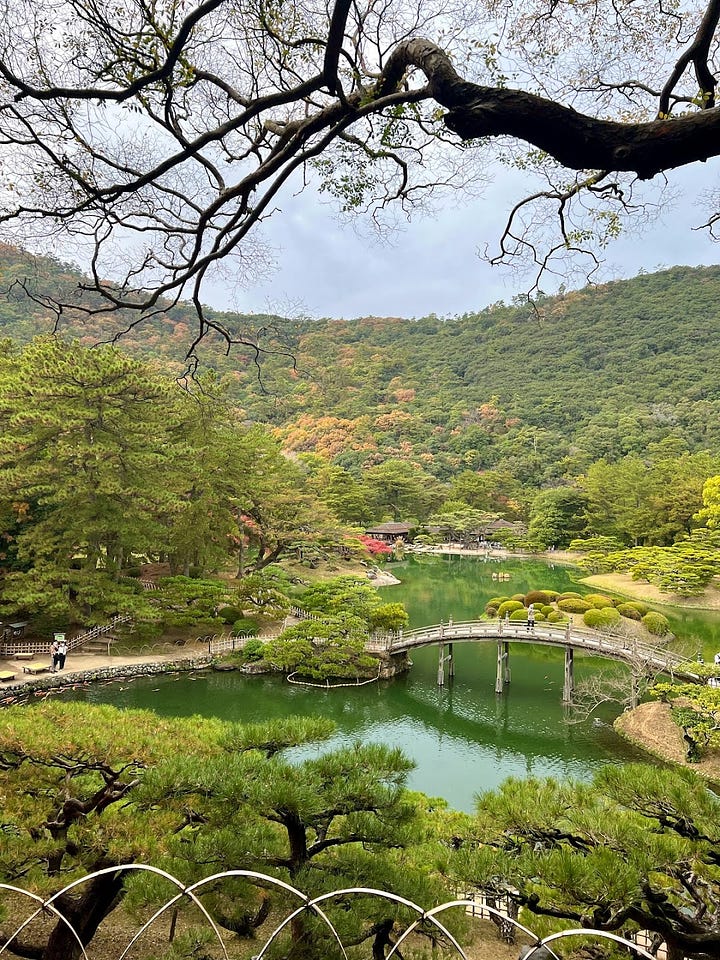
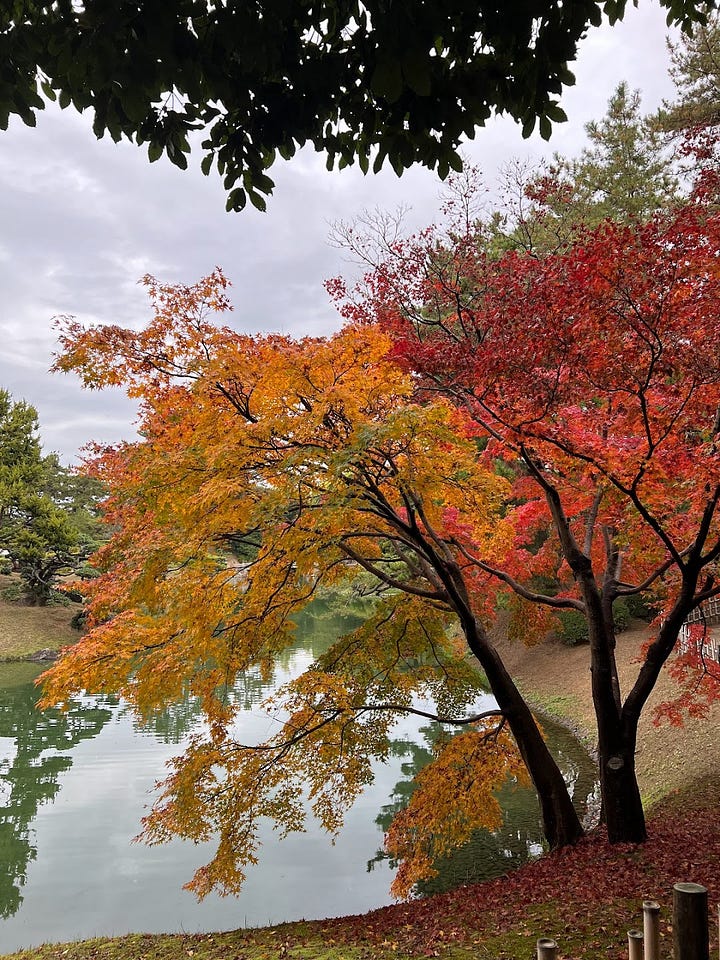
After spending the afternoon exploring the garden, take a stroll through Takamatsu’s Marugame-machi - a pretty glass-topped shopping arcade lined with trees. For dinner, you could check out Yoridorimidori nearby, a casual restaurant serving up another Kagawa regional speciality - chicken on the bone, which pairs wonderfully with side dishes of agedashi tofu, pickles and beer for a fulsome dinner. You can choose between “adult” and “young” chicken - whilst the former has a more mature flavour, I would recommend the “young” chicken for its tenderness.


Alternatively, for something a bit more upscale and special, you can check out Yakiniku Nakamura for sumptuous Japanese BBQ and sukiyaki (beef simmered in subtly sweet broth), cooked to order at your own table. The best part is arguably the thick sanuki udon that you can have plopped into your leftover broth afterwards to soak up all that delicious umami flavour. Private rooms are available, making this an ideal place for dinner with a group of friends. Booking is recommended!
Day 3: Konpira-san / Iya Valley
No trip to Shikoku is complete without paying your respects at Konpira-san, formally known as Kotohira-gu. This is the most popular shrine in Shikoku, comprising several buildings dotted along the steep terrain of Mount Zozu. Whilst the climb up can get pretty tough in some places, you’ll be rewarded with beautiful views as you ascend higher into the trees.
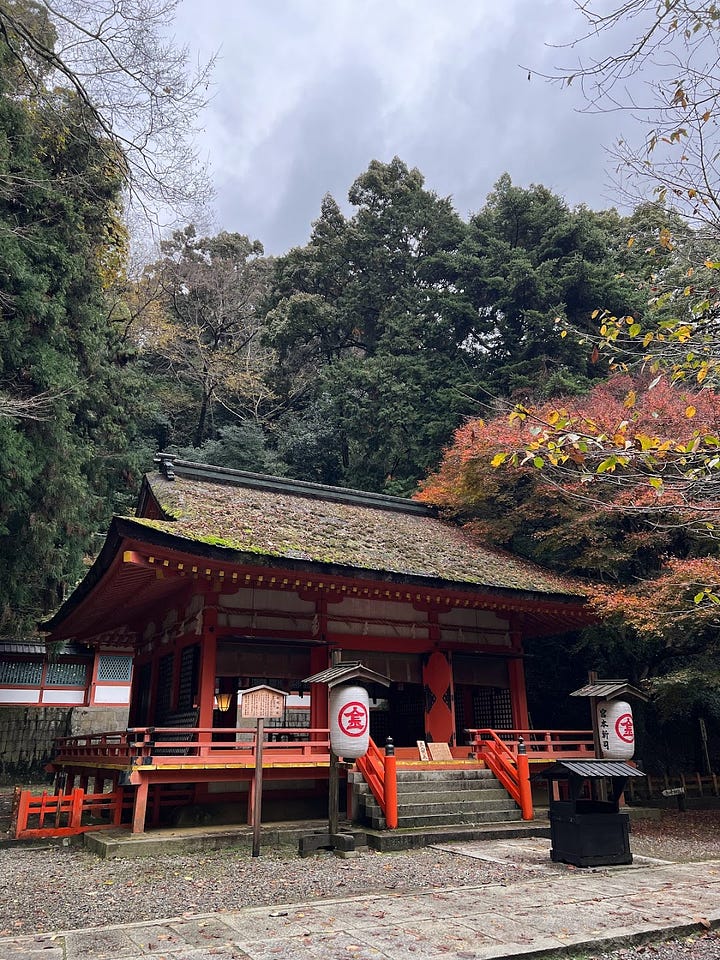
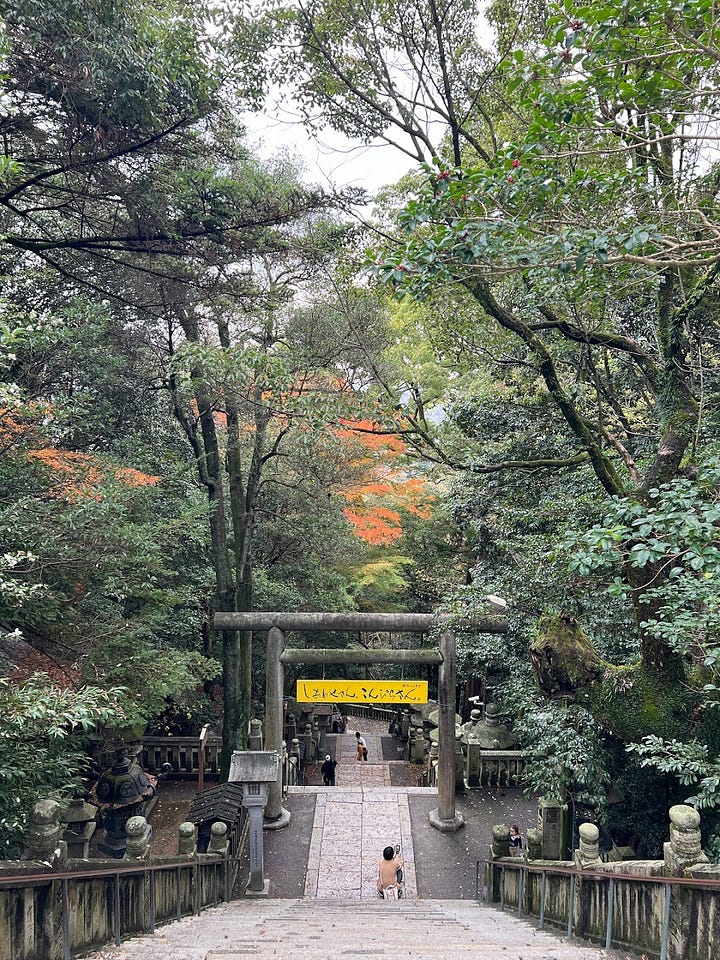
You can choose to approach via the touristy shopping arcade (which has some pretty steep stairs), or you can drive directly to this car park to cut this bit out, which is what we did.
After your morning hike to Konpira-san, hop back into your car to make the 1-hour journey down into your second prefecture out of four, Tokushima, where you’ll find the Iya Valley - a remote, mountainous region with steep slopes and scenic rocky gorges, traditionally crossed via intricately knotted vine bridges. This is truly off-the-beaten-track Japan, and shouldn’t be missed by those who seek tranquillity and seclusion in nature. As with the rest of the country, it’s particularly stunning in autumn when the trees lining the valley turn fiery red, burnt orange and mellow yellow in equal measure.


Where we stayed in the Iya Valley
Obokekyo Mannaka: this lovely hotel has a hot spring and a delicious Japanese breakfast spread to offer. Rooms are the perfect marriage of Japanese tradition and Western modernity and are spacious and comfortable. Free parking is available at the front of the hotel. Note that it is situated at the beginning of the valley, so you will have to drive significant distances on winding roads to access attractions that are further in.
There are pretty limited dining options in the Iya Valley, but Senkichi is well-known for its soba noodles. The restaurant in the nearby Iya Bijin hotel is also a great option for trying the warming, hearty Iya Valley regional specialities.
After enjoying your lunch, you can either enjoy a leisurely ride on the Oboke Gorge sightseeing cruise to soak in the sights of the valley from below, or you might feel brave enough to traverse the famous vine bridges that are dotted around. This one is quite accessible and located near to a car park, tourist centre and the Biwa Waterfall. There is also the Oku-Iya Double Vine Bridge which some prefer given that it is less congested, but it is located a lot further into the valley, so it may require a long drive to get to depending where you’re starting from.
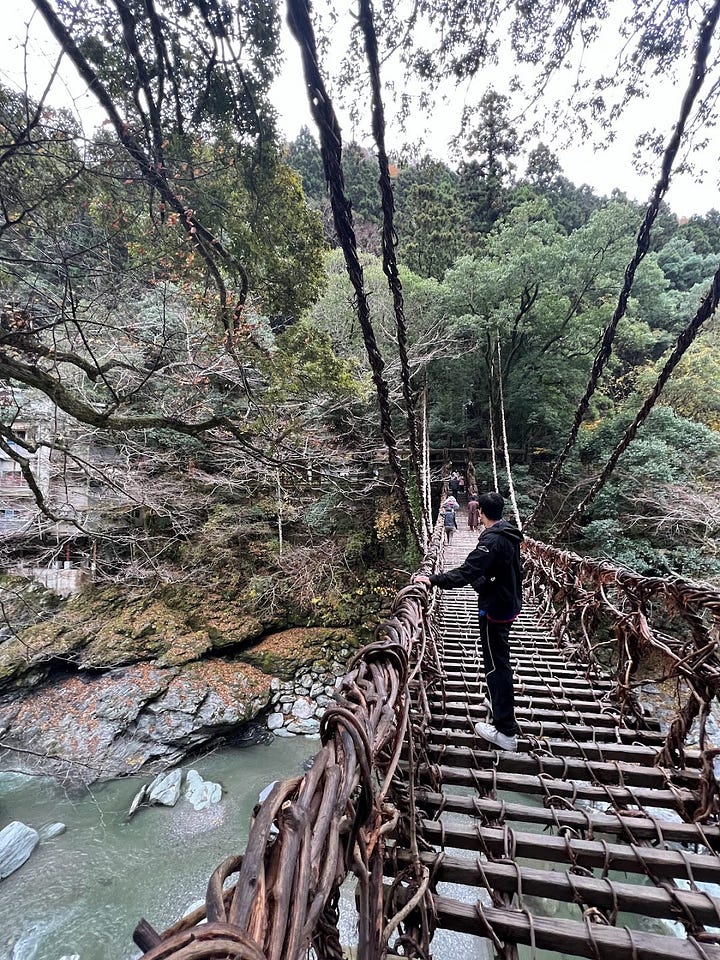
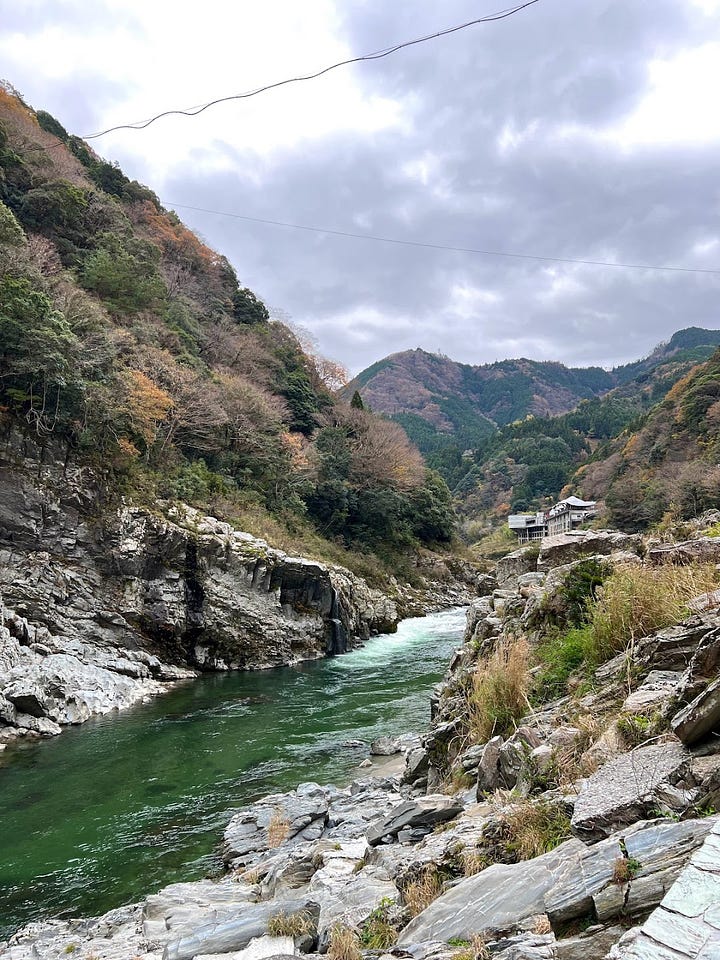
Whilst I found crossing the vine bridge to be pretty exhilarating and fun, it’s not for the faint-hearted or elderly with poor balance - there are big gaps in between the boards and you’ll definitely feel every gust of wind or movement, so proceed with caution and secure any loose items before making your way across!
If you’re willing to travel deeper into the valley, a truly idiosyncratic and memorable attraction is Nagoro Village, otherwise known as the village of the scarecrows. Its origins can be credited to a local artist who made life-size cloth scarecrows to represent each former inhabitant of the village as people started moving away and the population naturally declined. As of my visit in 2022, there were 200 scarecrow dolls to the 27 real people that still call Nagoro home, with each scarecrow imbued with its own unique personality, expression and outfit to mimic that of its human counterpart.
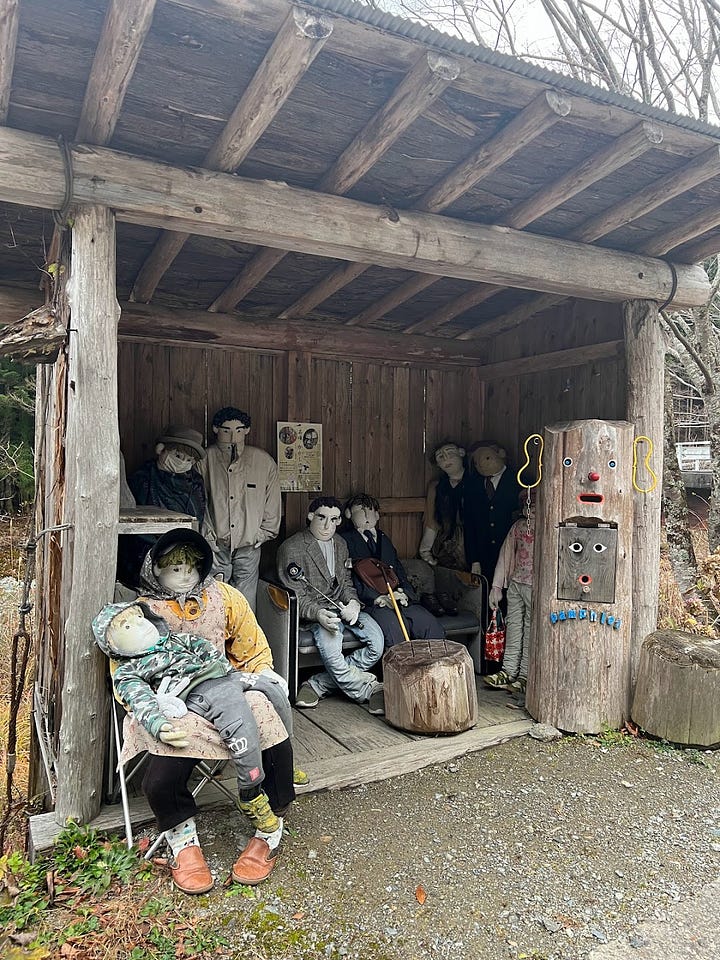
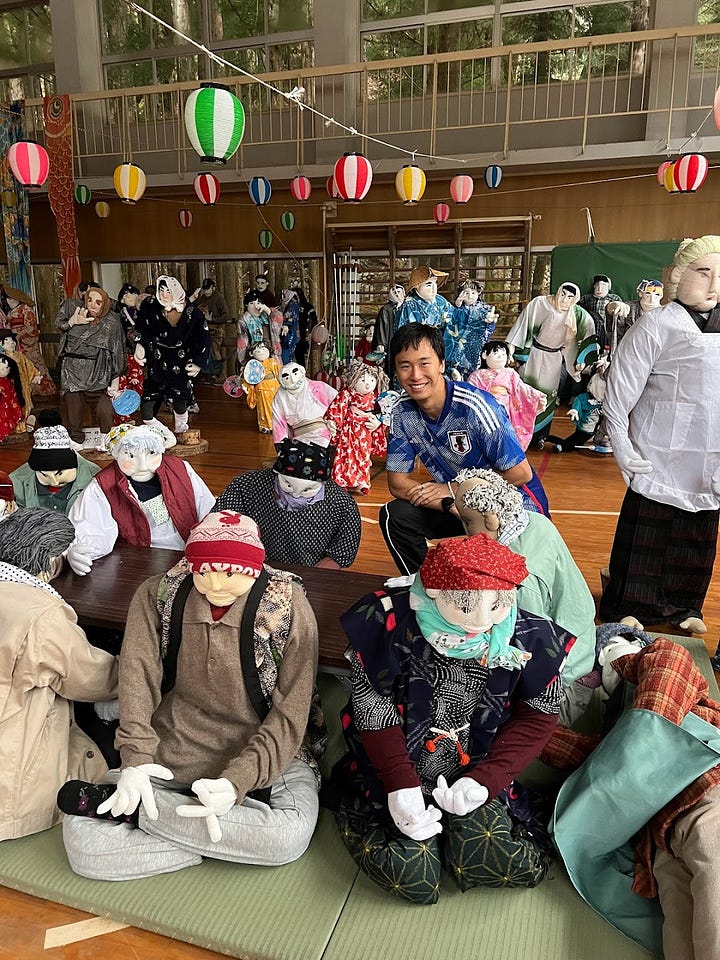
Wandering around this deserted rural village with these fully dressed dolls carefully posed to sit at bus stops, tend to gardens, engage in tea ceremonies in otherwise empty homes and even participate in a full on sports day-esque celebration at the abandoned primary school truly makes for a fascinating and slightly bone-chilling visit, and it’s one I’d genuinely recommend (but probably not by yourself, and not after dark). The scarecrow of James May complete with a handwritten note hanging around his neck at the school does help to lighten the mood somewhat though.
As mentioned earlier, given that there are limited dining options in the Iya Valley, it would probably be best to dine in your hotel if there is the option to in the evenings. Otherwise, you can always go for a conbini dinner from the Lawson in town - honestly, this is a must-try gourmet experience in itself!
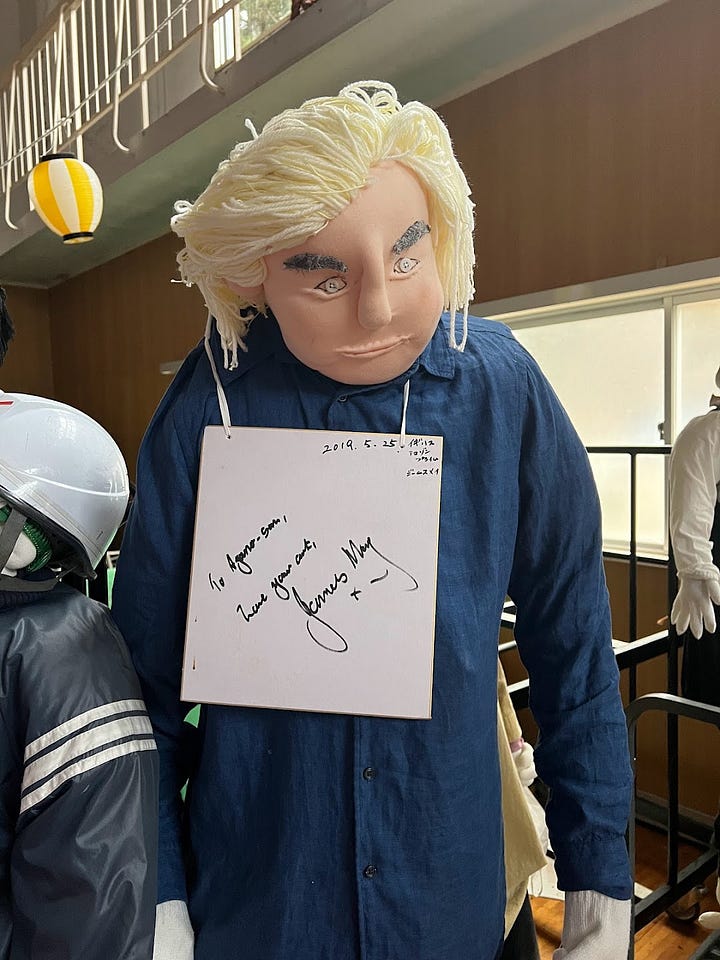

Day 4: Kochi
Kochi is the capital city of Kochi prefecture, located on the southern side of Shikoku on the coast. This compact, chilled-out city can easily be explored in one day, starting with the serene and beautiful grounds of Chikurinji Temple, one of the stops on Shikoku’s 88-temple pilgrimage trail located at the top of Mount Godaisan. With its five-tier vermilion pagoda, lush greenery and miniature stone Buddha statues dotted around, this is definitely not one to miss.

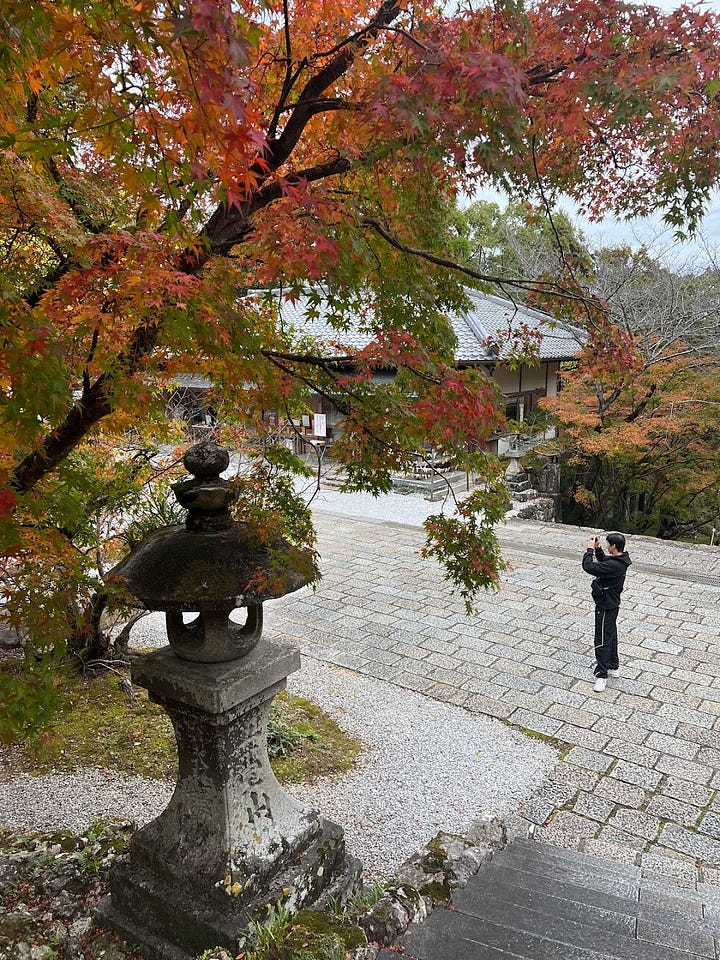
Next door to Chikurinji Temple is Godaisan Park, which offers wonderful views of Kochi from above, and the Makino Botanical Garden, where you can marvel at the 3,000 plus plant species in the carefully maintained greenhouses and walking trails here.
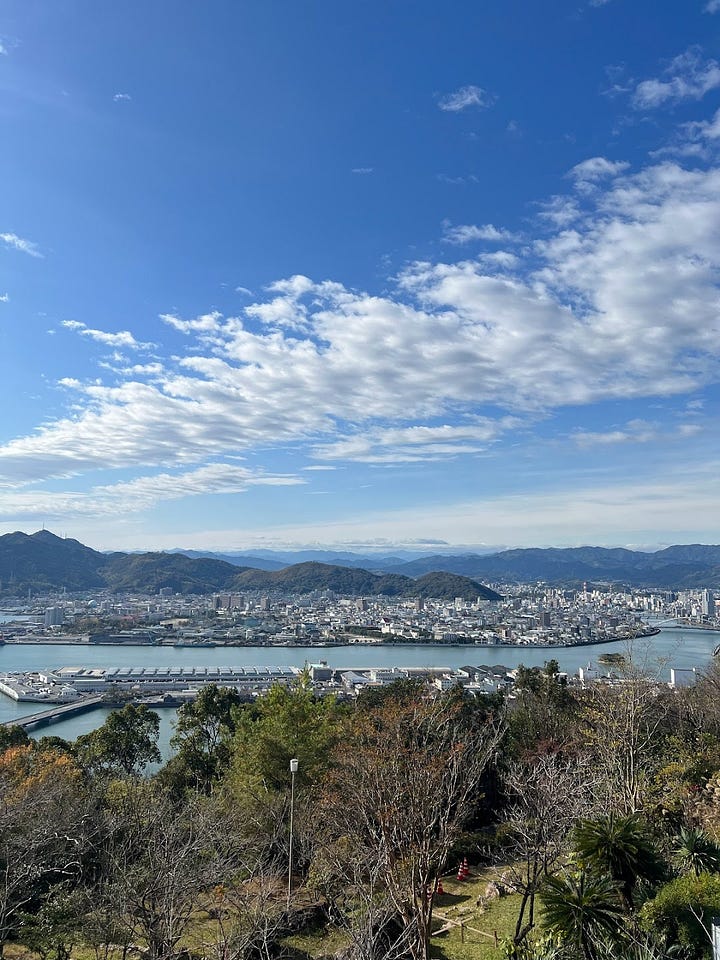
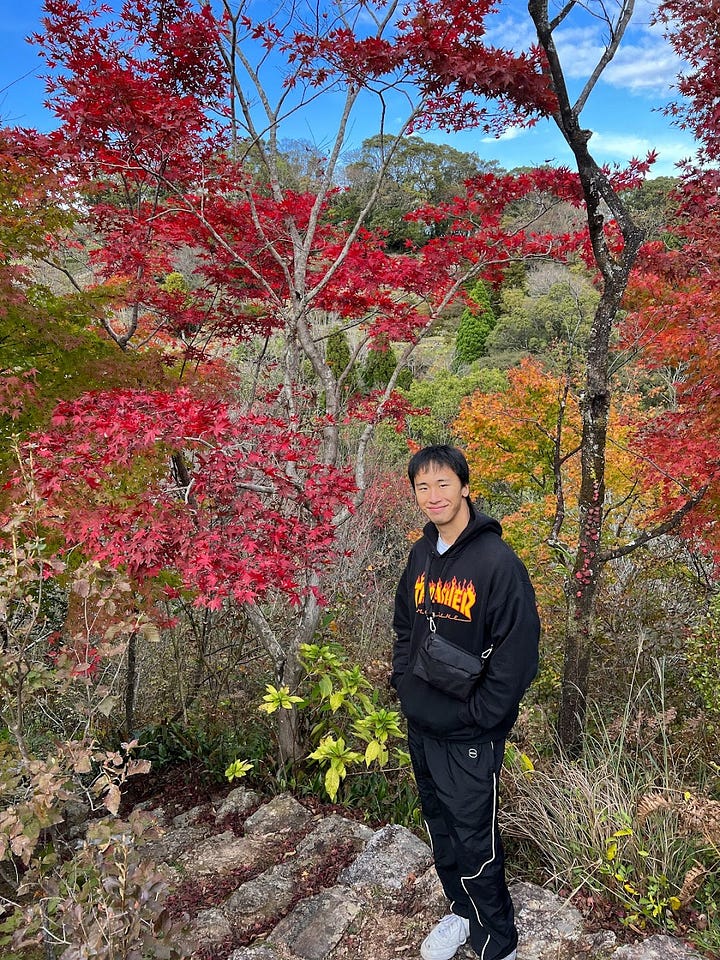
Once you’re ready to come down Mount Godaisan, make a beeline for the kitchen of the city - Hirome Market. This indoor market is full of food stalls selling Kochi specialities, including the prefecture’s most famous dish katsuo no tataki, which is bonito sashimi traditionally seared over a straw fire. After eating your fill, head to Kochi Castle to explore the grounds and museum and enjoy the stellar view over the city. Be warned that the climb up is quite steep and there are steep stairs within the castle itself, but it’s worth it.
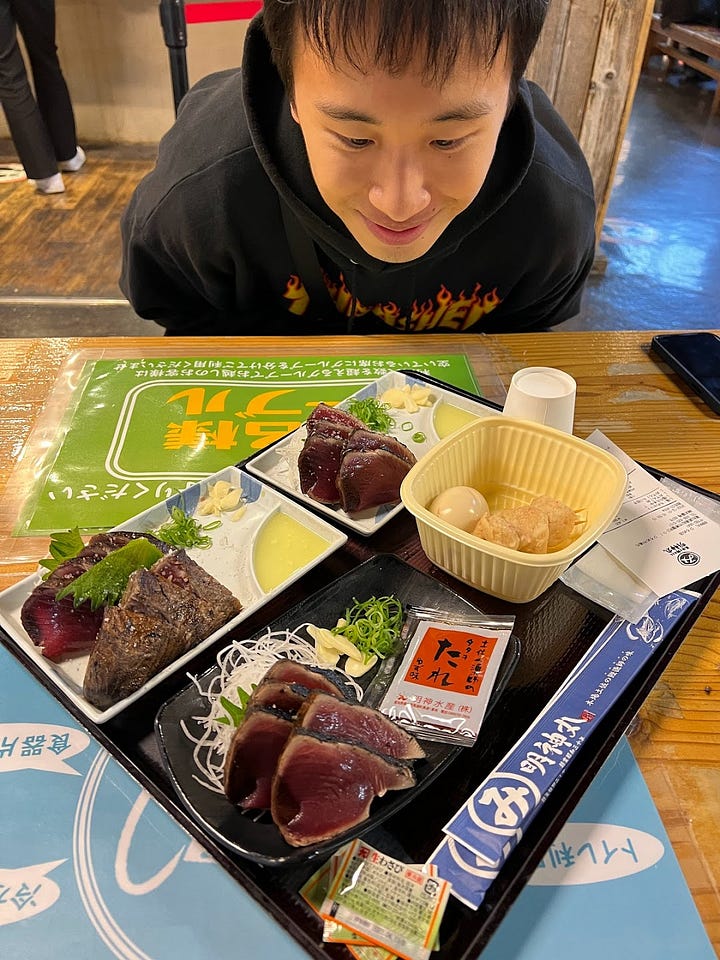
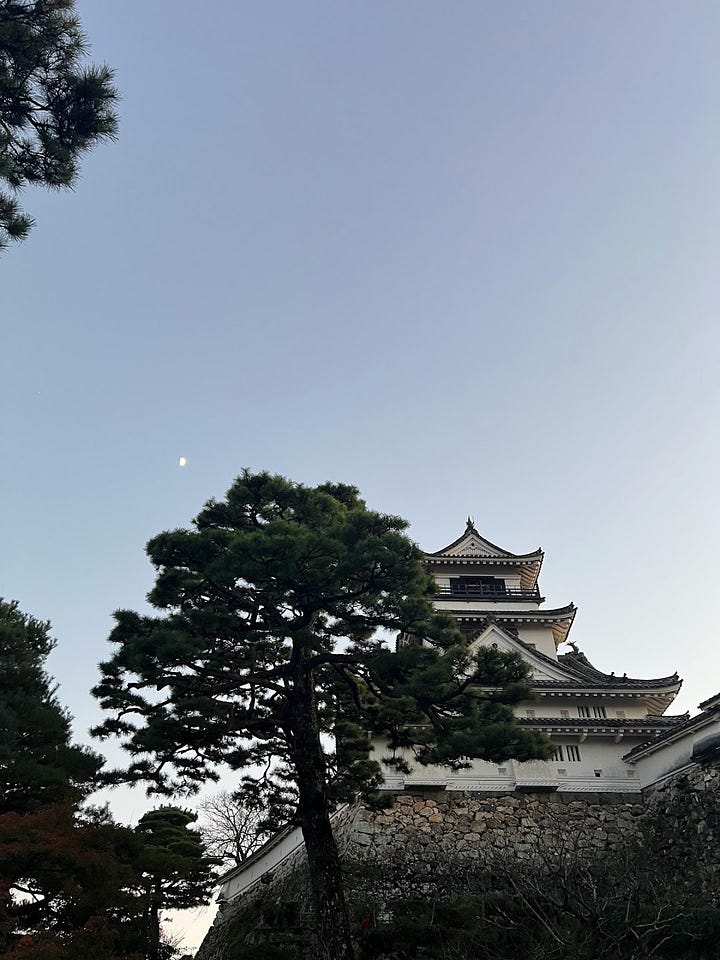
For dinner, we found this local izakaya (Japan’s answer to a pub) near our hotel called Habotan which serves up traditional small plates designed to be enjoyed with alcohol. For more adventurous eaters, you can even try horse sashimi here, which is quite popular in Japan. I found it surprisingly tasty, especially when eaten with ginger / garlic / spring onions!
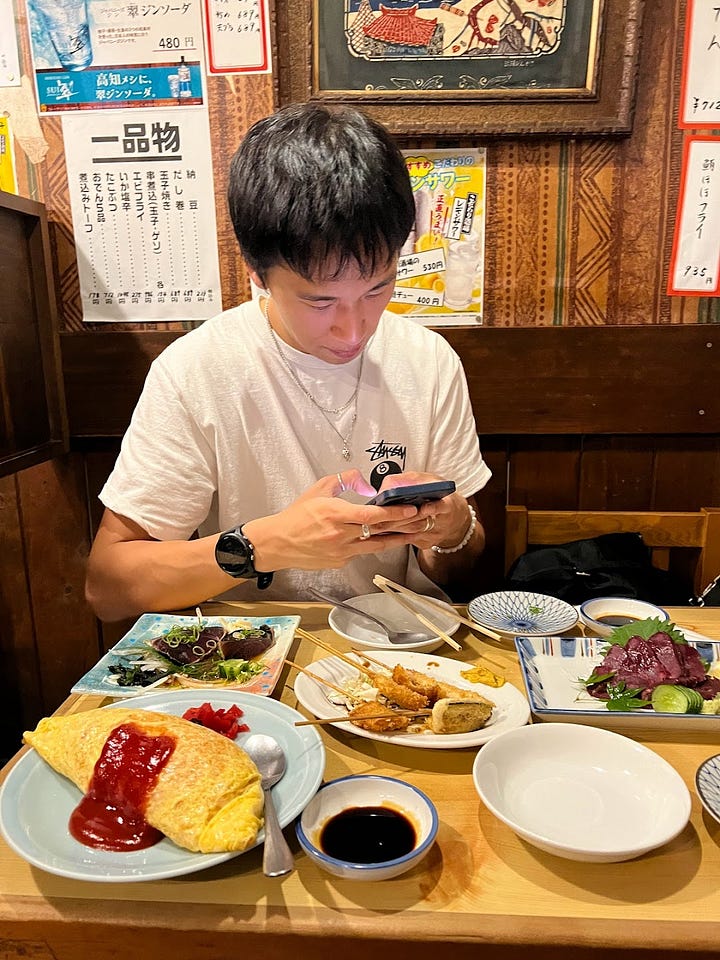
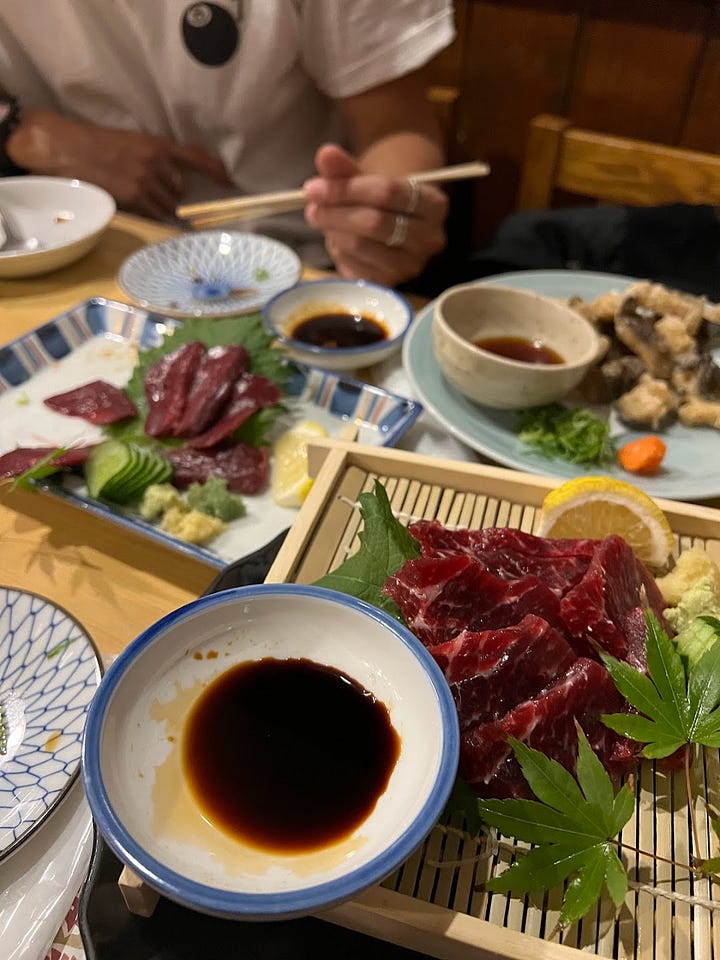
Where we stayed in Kochi:
Comfort Hotel Kochi: a very spartan but clean budget hotel right in the city centre with parking available and a generous buffet breakfast. Don’t expect any luxury touches, but it’s fine for one night in Kochi.
Day 5: Nakatsu Gorge / Matsuyama
Before moving on to your fourth and final prefecture, stop by Nakatsu Gorge, where you can enjoy a beautiful walk (with the option to ascend higher and make it a hike) against a backdrop of forests, rocks and waterfalls. People come here from afar to marvel at the famous “Niyodo Blue” colour of the waters here, but unfortunately the weather wasn’t quite good enough for us to see this impossibly azure shade when we visited. Nevertheless, the gorge was more than worth it on its own.
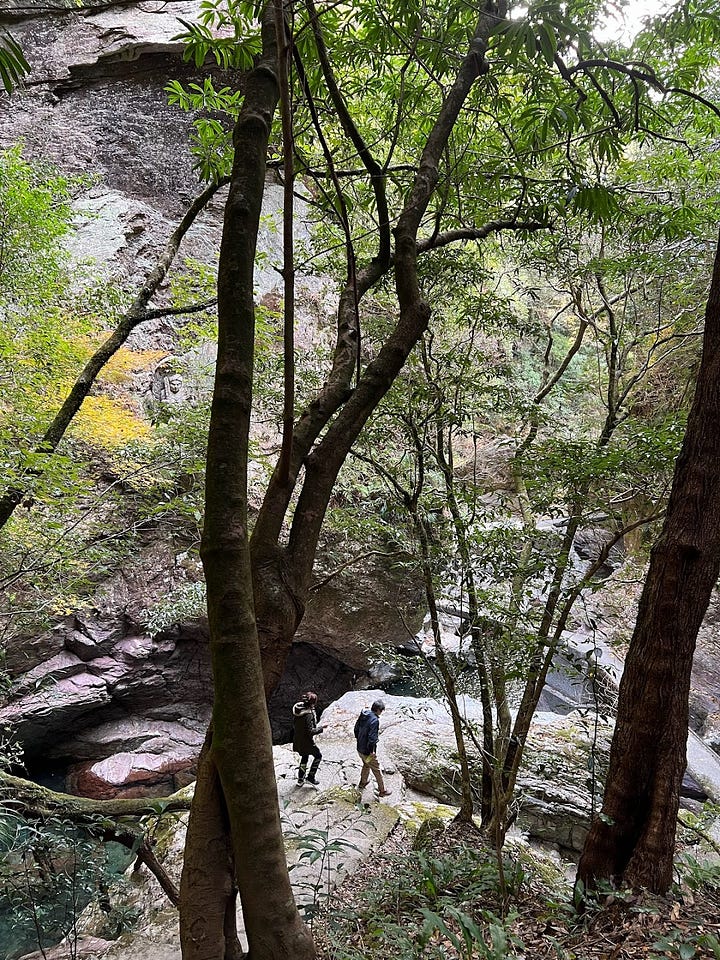
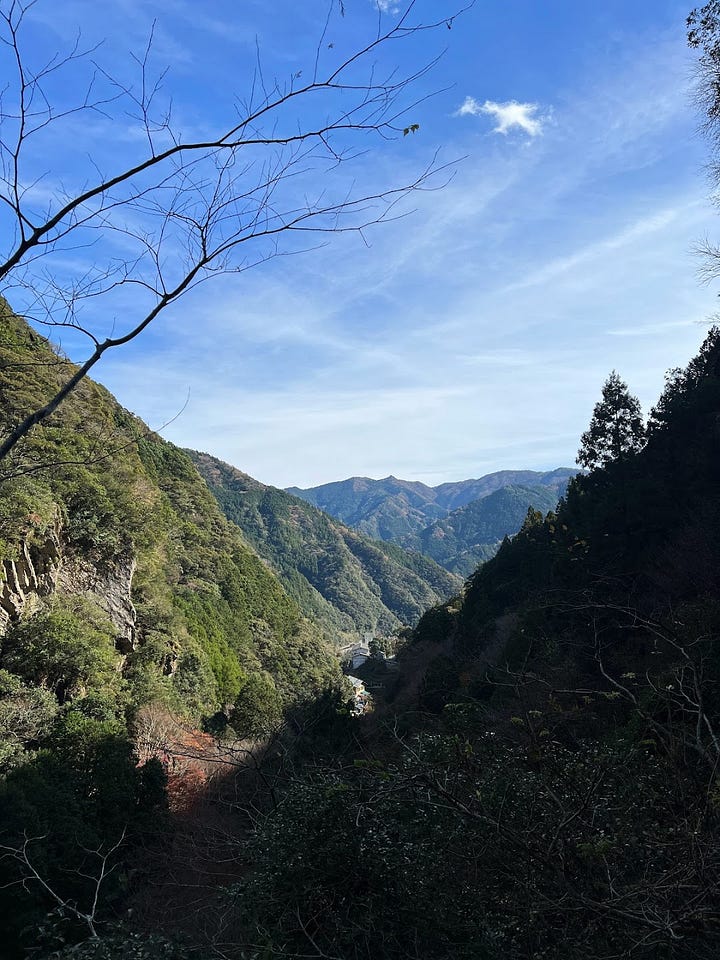
After enjoying the gorge, head northwards to Matsuyama, the capital of Ehime prefecture and Shikoku’s largest city. Ehime prefecture is famous for its tai meshi, or sea bream rice, and Tai Meshi Senmon Taiya is a traditional restaurant in Matsuyama that specialises in the cooked version of this dish (there is a sashimi version that is commonly eaten in southern Ehime). The restaurant is located in a beautiful old Japanese home complete with tatami mats and paper sliding doors, and makes for a lovely lunch stop before delving into the city’s attractions.
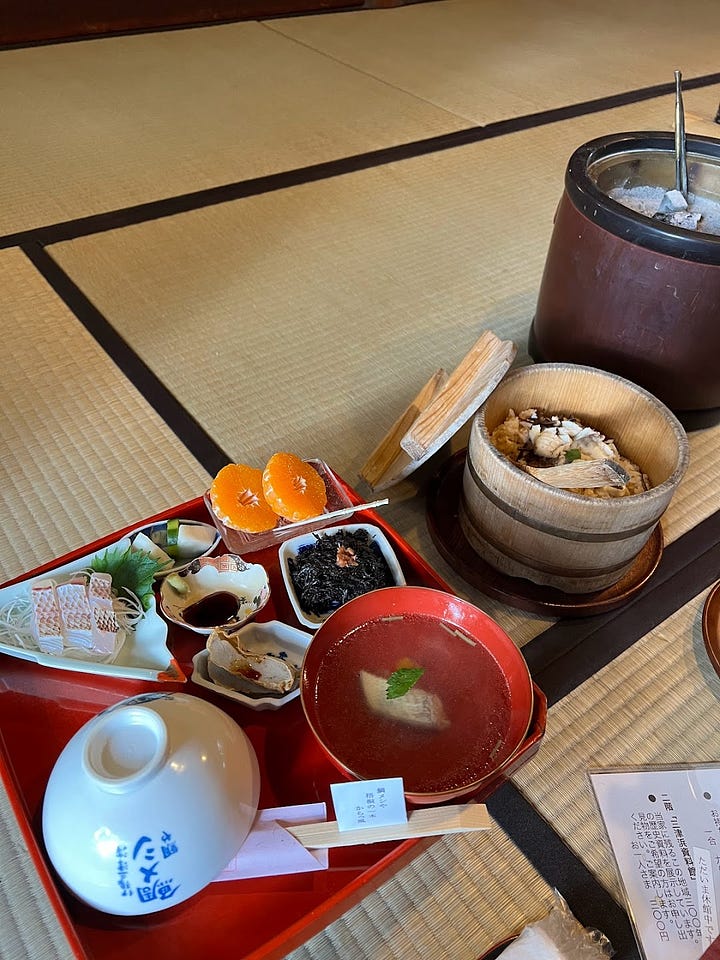
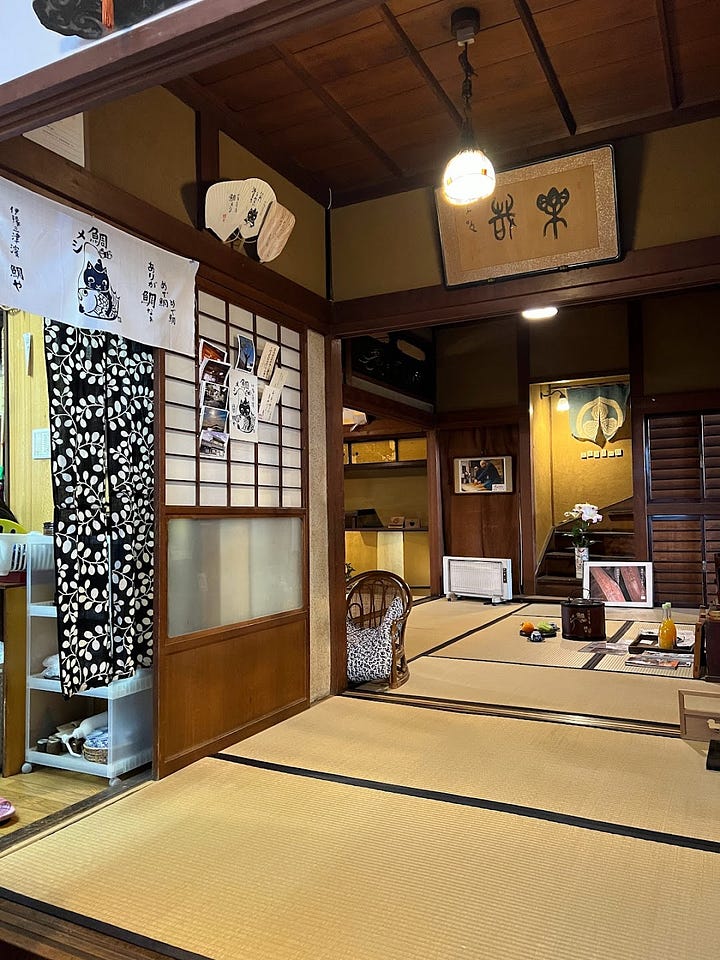
You would not be able to visit Matsuyama without seeing Matsuyama Castle - one of only 12 original castles in Japan, and an iconic spot for cherry blossom viewing during spring. Located at the top of a steep hill, there are various options for getting yourself up there - by a 15 minute hike, a leisurely cable car ride or a somewhat thrilling chairlift journey, which is the option we went for and would highly recommend! Note that the cable car and chairlift both leave from the same station.

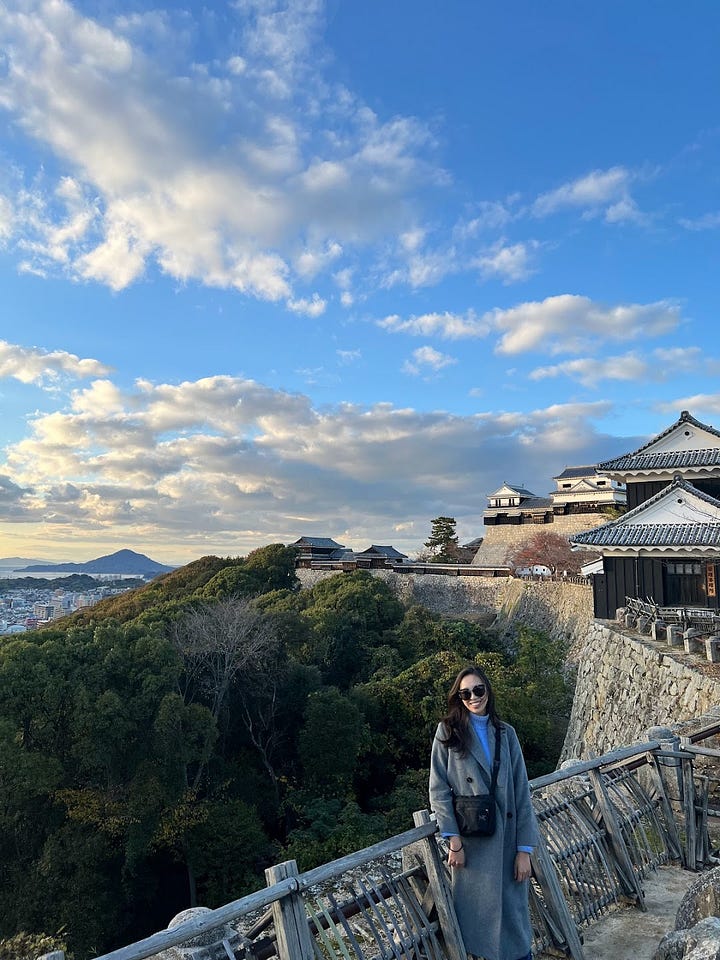
After enjoying the stunning views from the castle and strolling around the expansive grounds, come back down to explore the Ropeway Shopping Street at the base of the mountain where the cable car / ropeway station is located, as well as the expansive shopping arcades of Okaido and Gintengai. You will notice that a lot of the souvenirs and snacks on sale here centre around mikan, or Japanese satsuma, which is what Ehime prefecture is famous for. This thin-skinned, sweet juicy fruit is definitely something you must try whilst here - be that in jelly, sorbet or juice form!
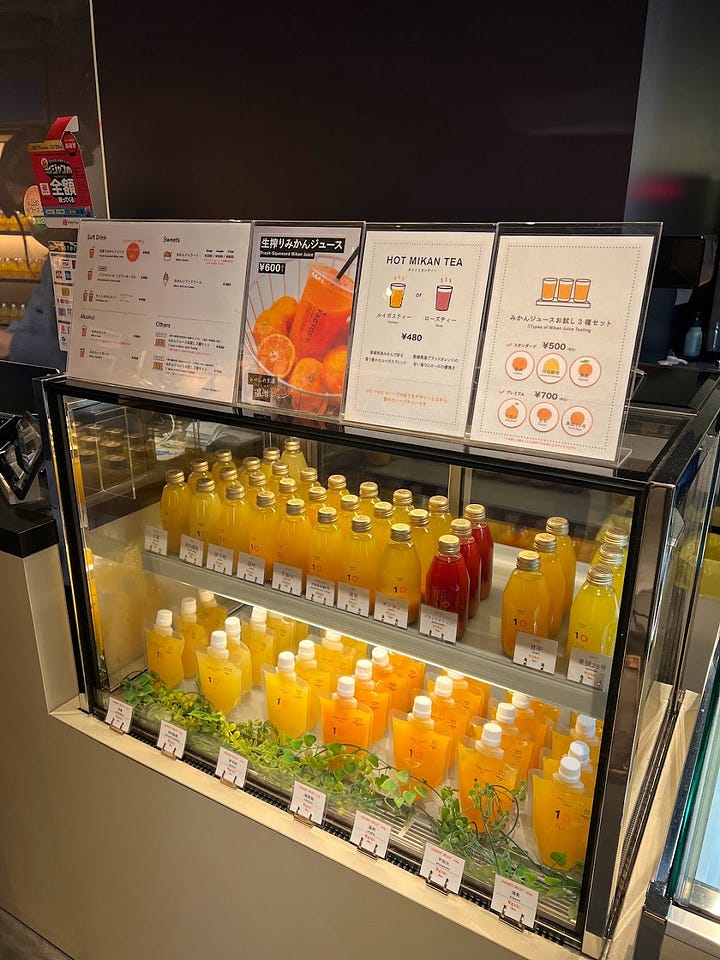
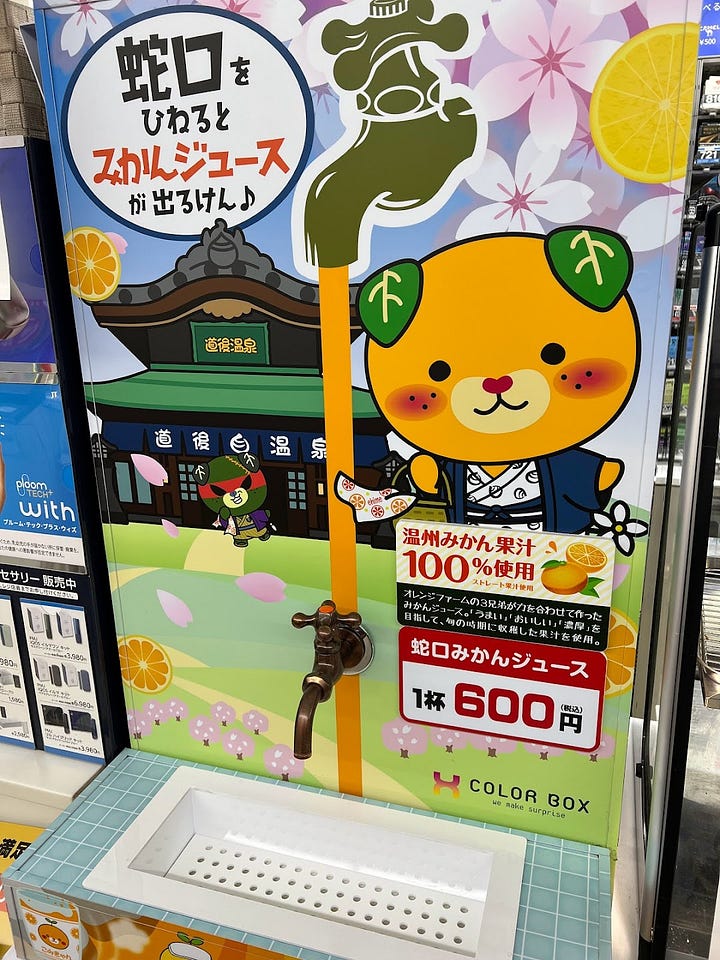
The other undeniable draw of Matsuyama is Dogo Onsen, one of Japan’s most famous hot spring resorts. It isn’t surprising to see people walking around here in their yukata / bathrobe and slippers, holding a basket of toiletries. Whilst there are lots of sights to enjoy in the area, such as the Sky Walkway and Botchan Karakuri Clock, the most famous attraction is undoubtedly Dogo Onsen Honkan, a Meiji-era traditional bath house which is said to have inspired Spirited Away. As with any bath house in Japan, be aware of proper onsen etiquette - you’ll have to wash yourself thoroughly in the separate shower area before soaking in the public baths’ hot, restorative waters.
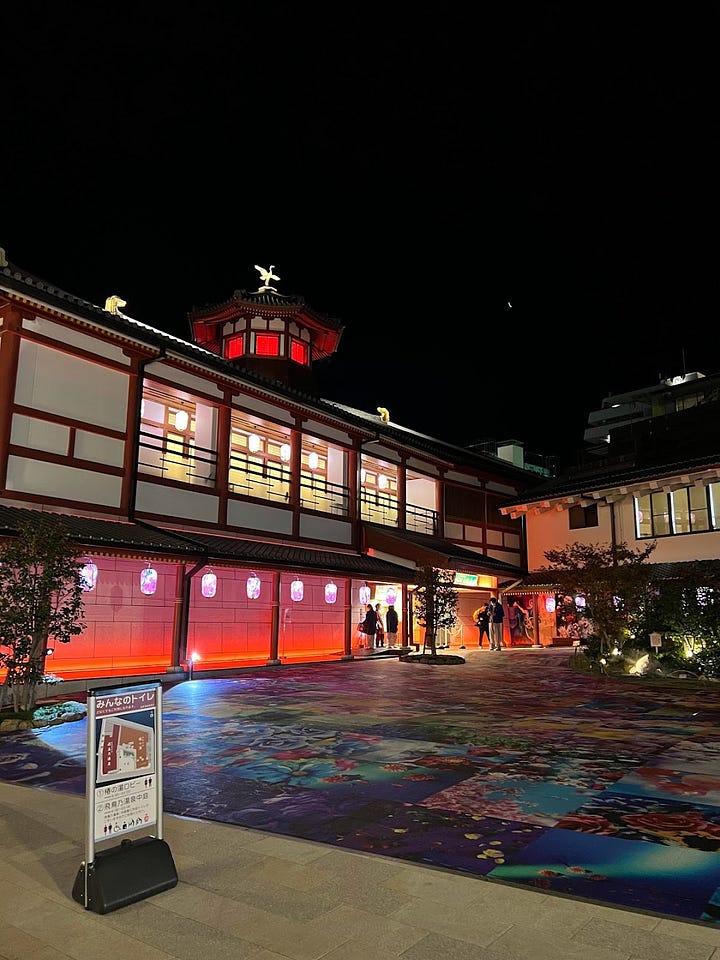
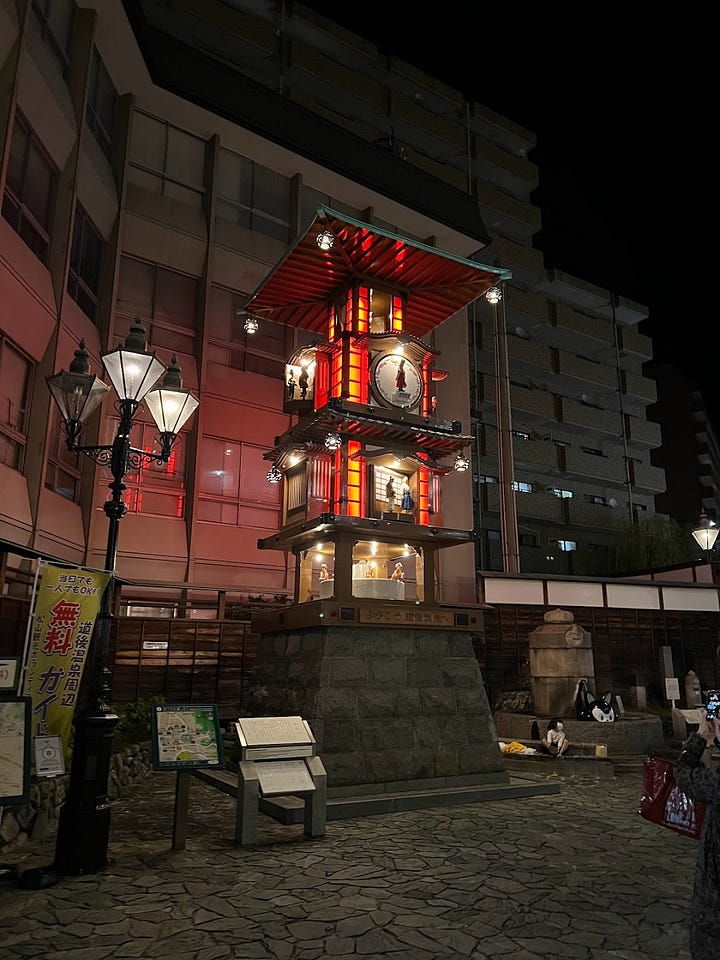
Given Dogo Onsen Honkan’s popularity, you might want to skip any potential wait by going to the secondary bath house annex, called Asuka-no-yu which is right next door. This building is also beautiful in its own right, with elegantly decorated relaxation rooms on the top floor that you can enjoy after your bath.
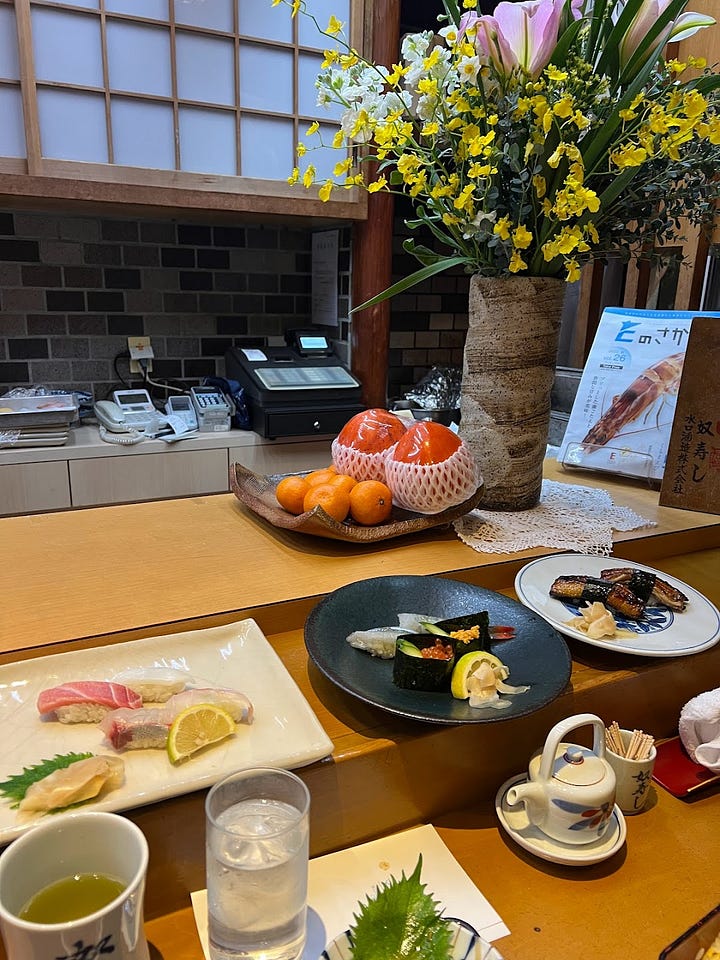
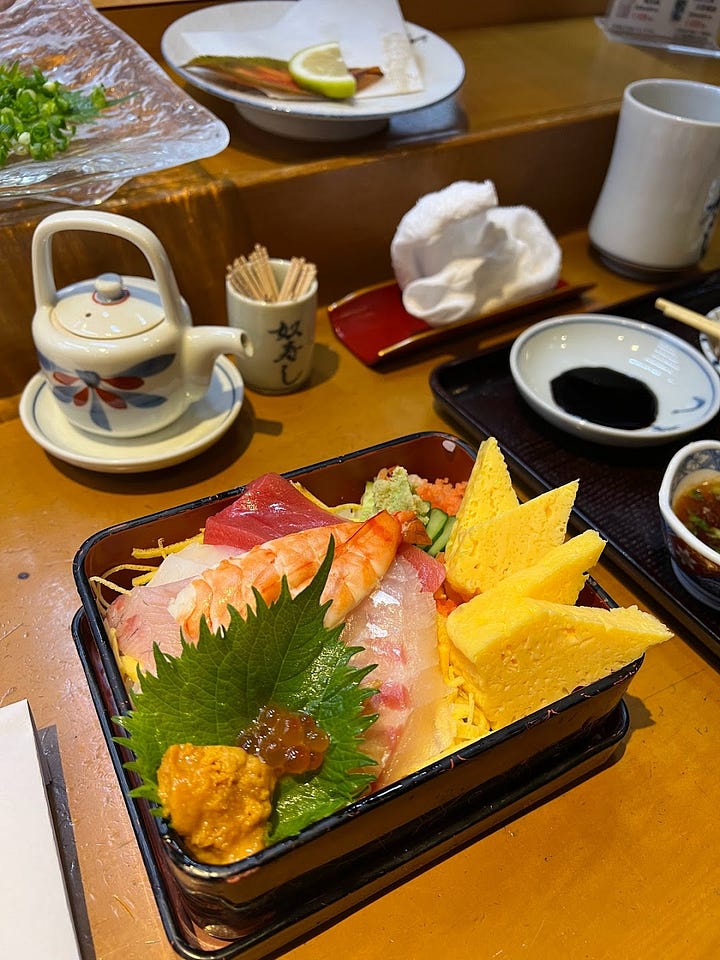
A lovely dinner option in the Dogo Onsen area is Yakko Sushi, run by a father-and-son duo. We sat at the counter and enjoyed the chefs’ friendliness and their thick cuts of fish, but be aware they can be heavy handed with wasabi, so err on the side of caution and tell them to use less if you’re sensitive to this!
Where we stayed in Matsuyama:
Dogoya: This is a very traditional ryokan, or Japanese-style guesthouse with tatami floors, sliding paper doors and shared bathrooms, located a stone’s throw away from the main Dogo Onsen area. Our room was very spacious and we enjoyed Japanese hospitality immensely whilst here, but be aware that insulation is not the best in this old building so it can get pretty cold inside! Luckily, we had a kotatsu (heated table) that proved invaluable and extremely thick futons that completely sealed off any feeling of cold once snuggled underneath.
Day 6: Naoshima
For your last proper day in Shikoku, start by making the two-and-a-bit hour drive back east towards Takamatsu, where it all began. The idea is to arrive as early as possible so you have the maximum amount of time to explore the unmissable art island, Naoshima. Regular ferries depart from Takamatsu port to Naoshima, but ensure that you are clear on when the last ferry returns from Naoshima to Takamatsu - you don’t want to be stranded on the island!

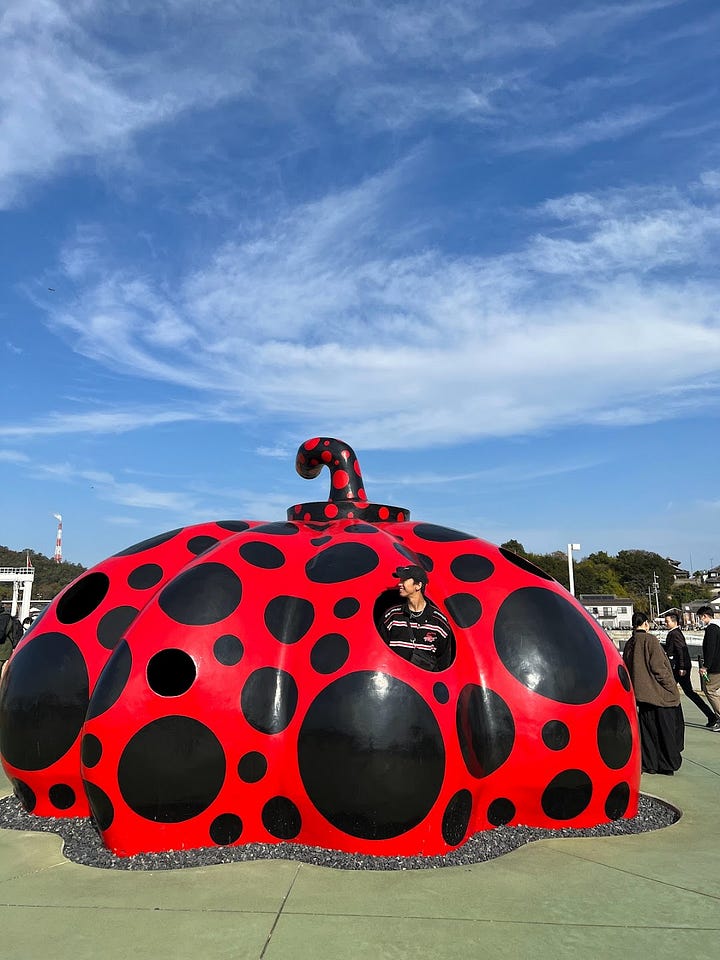
Whilst it is possible to get around Naoshima by rental car (check to see if your ferry accepts cars) or public bus, by far the easiest and most popular way to traverse the small island is by bicycle. You can rent a normal / electric-powered bicycle from one of the hire shops nearby the port when you disembark the ferry - whilst the electric-powered bicycles are slightly more expensive, I believe they’re worth it because Naoshima is pretty hilly in places.
It’s impossible to miss Yayoi Kusama’s Red Pumpkin, since it’s literally at the Miyanoura Port where you first arrive onto Naoshima. Kusama’s presence on the island is definitely felt through the polka-dotted public buses and of course, the iconic yellow Pumpkin by the sea, which is a short cycle away from the port (although note that you’ll have to lock up your cycle before entering the beach area, since this belongs to Benesse House). The surrounding Benesse Art Site has various other art pieces dotted around which are worth checking out, and you can also visit the nearby Benesse House Shop which sells adorable Yayoi Kusama merch.
Whilst there is no shortage of contemporary art museums on Naoshima, it is a truth universally acknowledged that if you only go to one, it should be the Chichu Art Museum. There’s a free shuttle bus that runs from the beach area to Chichu (with stops at the Benesse House hotel and the Lee Ufan Museum in between) which takes about 7 minutes. You can also easily walk in between museums.
Chichu is housed within a Tadao Ando-designed building which is itself a work of art, being partly underground and cleverly making use of natural light alone to illuminate the exhibits within. Such exhibits include breathtaking Monet murals and evocative James Turrell works - even as someone who doesn’t always find art museums too interesting, I absolutely loved visiting Chichu and would highly, highly recommend it to anyone visiting Naoshima. Note that if you would like to visit, you must book tickets in advance for a specific date and time, and you are not allowed to take pictures of the art when inside.

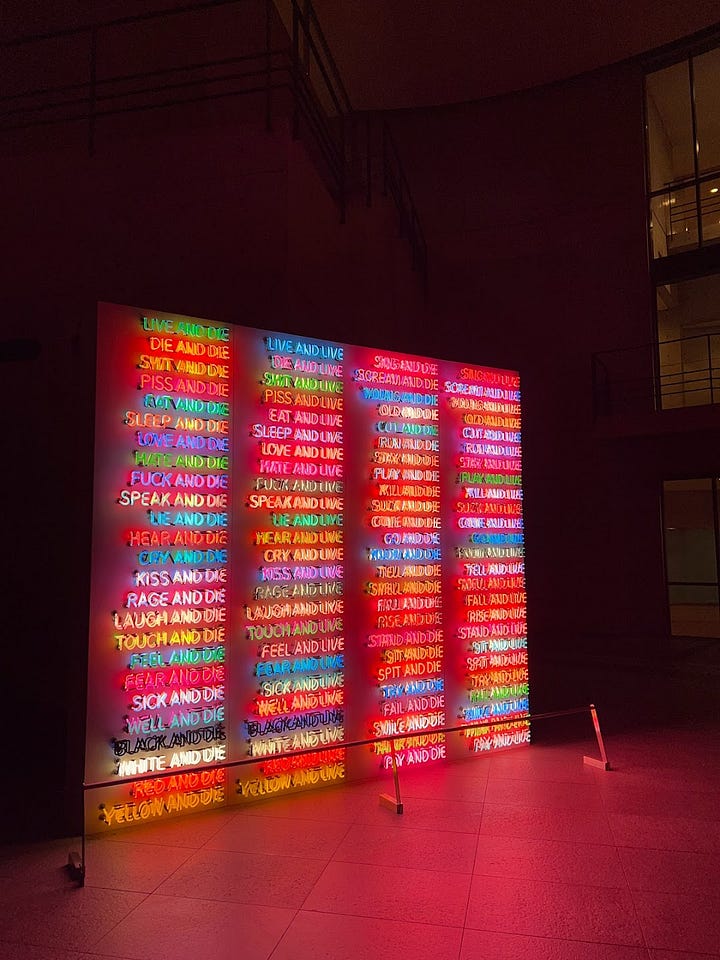
The only other museum we had time to visit before closing time was the Benesse House Museum, also designed by Tadao Ando. During the day this museum offers stunning views of the Seto Inland Sea.
Before catching the last ferry back to Takamatsu, we decided to kill some time by stopping by the quirky I love Yu Bathhouse, which markets itself as part art installation, part public bath with its eye-catching exterior and zany interior. I wouldn’t say this is an essential stop in Naoshima, and it’s not the best in terms of actual bathing experience, but it’s definitely a fun place to end the day at.
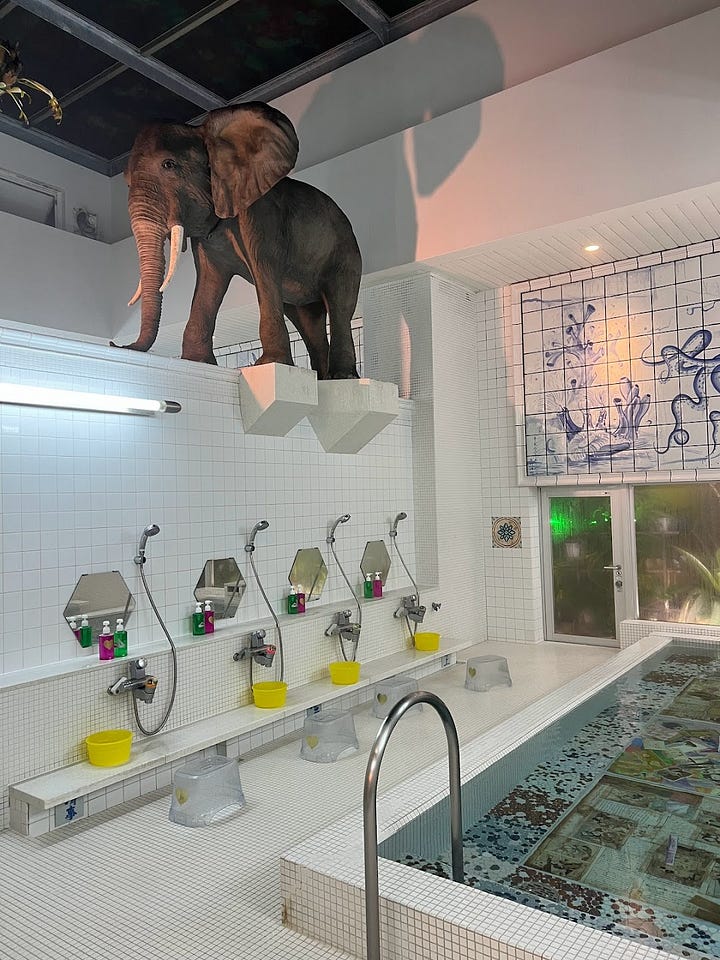
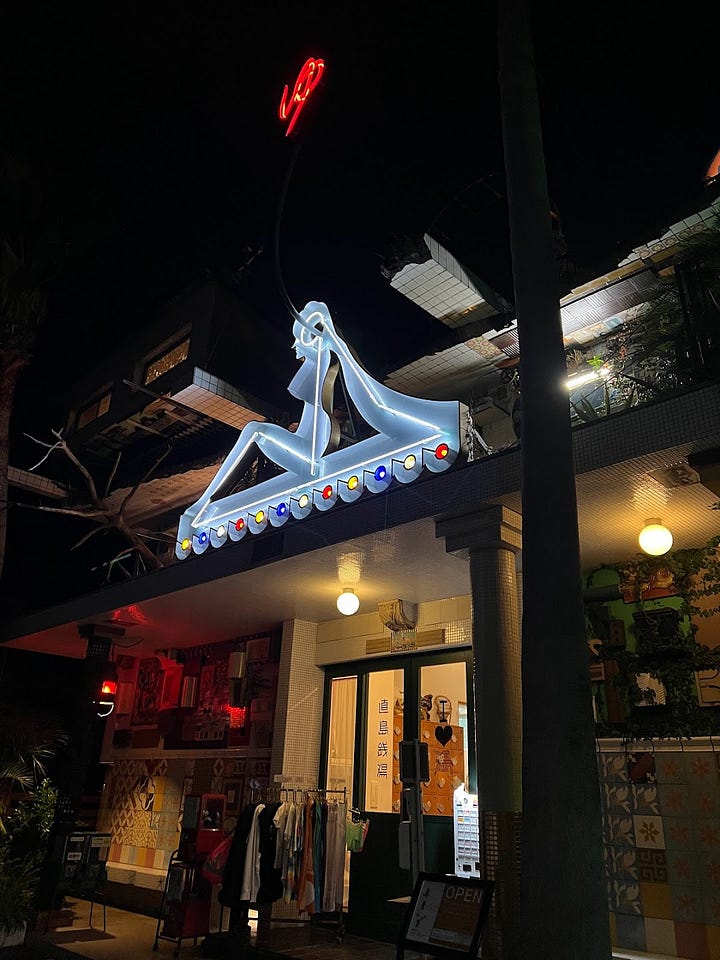
Whilst we felt content with only spending one day in Naoshima, art buffs may want to have another day to check out the other illustrious museums. The best hotel to stay at on the island is, of course, Benesse House, but be aware that rooms are sold at a premium here and get booked out very quickly. We instead decided to go back to Takamatsu and stay at a hotel near the port for ease.
Where we stayed in Takamatsu:
JR Hotel Clement Takamatsu: corporate, old-school Western-style hotel conveniently located next to the port. Nothing to complain about here - unmemorable.
Day 7: Osaka
Time to drive along the coast of Shikoku back towards Osaka, ending your road trip… but of course, the fun doesn’t have to end there!
To read my 2 week "Japan for beginners” itinerary, click here, and to read my 4 day Kanazawa / Takayama / Shirakawa-go itinerary, click here! [coming soon]





